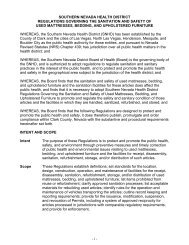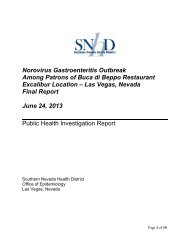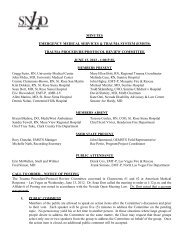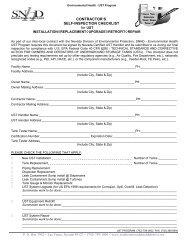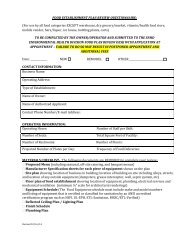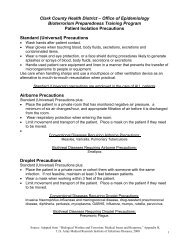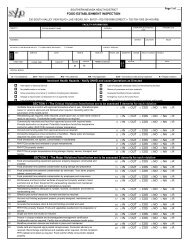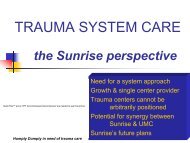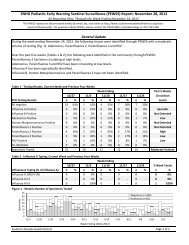Current Trauma Status Report - Southern Nevada Health District
Current Trauma Status Report - Southern Nevada Health District
Current Trauma Status Report - Southern Nevada Health District
You also want an ePaper? Increase the reach of your titles
YUMPU automatically turns print PDFs into web optimized ePapers that Google loves.
All EMS and ED stakeholders appear frustrated about the problem. The FAB and MAB, in conjunction<br />
with the Clark County <strong>Health</strong> <strong>District</strong>, have agreed to test eliminating the “emergency department<br />
closure” protocol and initiated a 90-day pilot on April 1, 2004. During this period, hospitals will not be<br />
able to close for one hour as previously allowed under the protocol. Instead, all patients are to be<br />
transported to the facility of their choice or to the closest facility, with the exception of trauma and<br />
burn patients. EMS providers will utilize the EMSystem EMS Offload Advisory levels to advise patients<br />
about the status of waiting times at the emergency departments when the patient is choosing a facility.<br />
Although this pilot project prohibits diversion, if a facility declares an internal disaster, all EMS traffic<br />
including inter-facility transfers to that facility will stop. Early indications are that the pilot test is<br />
having a positive impact.<br />
Information Systems<br />
There are two main components that make up a trauma information system: a trauma registry and<br />
prehospital data. In the case of <strong>Southern</strong> <strong>Nevada</strong> there are two trauma registries, one maintained by<br />
the <strong>Nevada</strong> State <strong>Health</strong> Division and another registry maintained by UMC. The registry kept by UMC<br />
captures more data than what is required by the State.<br />
With respect to prehospital data, each provider maintains their own database. The fire providers<br />
maintain electronic databases, while the ambulance providers maintain paper databases.<br />
In accordance with NRS 450B.810, NAC 450B.620, NAC 450B.645, and NAC 450B.766, State EMS, in<br />
cooperation with Clark County <strong>Health</strong> <strong>District</strong> EMS office, have adopted standards for prehospital data<br />
collection. Computer software and a web-based server have been provided for collecting and storing<br />
prehospital run reports and data obtained from all <strong>Nevada</strong> permitted EMS/Fire agencies.<br />
While not every agency is required to install and utilize the provided software, each will be required to<br />
submit the required data elements in a format that will allow uploading to the web-based server. The<br />
rollout utilizing the web-based server is scheduled for July 2004. Las Vegas Fire and Rescue and local<br />
ambulance providers are expected to adopt a new software system called Roam IT allowing for a<br />
standardized electronic reporting of the prehospital care report to be in place by April 2004.<br />
ED data reporting is voluntary and not conc lusive. However, State regulation does require the<br />
reporting by all hospitals of any trauma care provided. While it is mandatory that hospitals report<br />
trauma cases to the <strong>Nevada</strong> <strong>Trauma</strong> Registry, the reality is that many hospitals find it difficult to meet<br />
the requirement due to staffing issues and thus the registry suffers. The data the State does receive is<br />
published in an annual report. In addition to the mandatory trauma reporting, all hospitals must<br />
submit the Uniform Billing 92 Hospital Discharge data set.<br />
Other data sources exist, but there is not a data warehouse for EMS/trauma data in <strong>Southern</strong> <strong>Nevada</strong>.<br />
State <strong>Trauma</strong> Registry<br />
All hospitals are required by NAC (NRS 450B.120 and 450B.238) to submit data to the State on trauma<br />
patients. The State provides the definitions on patient types and data fields for inclusion in the trauma<br />
registry. Hospitals must submit quarterly reports to the <strong>Nevada</strong> State <strong>Health</strong> Division within 60 days<br />
after the end of the quarter. The <strong>Nevada</strong> State <strong>Health</strong> Division then publishes an annual report by July<br />
1 for the previous calendar year. The most current report was published on November 12, 2003 and<br />
provides data for 2000 through 2002.<br />
Page 54



